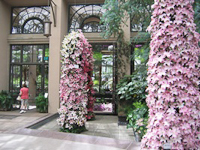| E-mail me at mcclainm@optonline.net | Visit my Facebook page | View my LinkedIn profile |

Alice was out for a run when we arrived, but Jacob and his friend Jay greeted us with a cool glass of water. A question about this year's crop elicited from Jacob a gloomy tale of leaf miners and snapping turtles. He was clearly worried. The first CSA pickup of the spring was scheduled for the next day, and it sounded as if there would be little to distribute.
 |
| Alice's garden at Kimberton |
Alice returned from her run in a cheerier mood. She took us out for a beautiful woodland walk - down a hill, through a swampy patch, then along the creek, across two grassy fields, to her gardens. There, contrary to Jacob's description, we saw row after row of beautiful healthy vegetables - onions, lettuce, spinach, parsley, kohlrabi and more - much of it ready for harvest. True, the spinach and chard were infested by leaf miners, but there was still plenty to harvest. "That's just Jacob," was Alice's take on it.
After a visit with Norbert and the other farm animals, we drove out to see Rainey (Lorraine), Paul's friend from his Amagansett Beach Club days, who has now become a friend of Alice. Rainey lives with her husband Bob and their two boys in a country compound in Chester Heights, as far off the beaten track as one can get in this part of the country. After several rounds of shotgun fire and fireworks we set out on an expedition to milk the cow and feed the horses on Bob's father's place, followed by a delicious 'meat fest' which Rainey had prepared.
The next morning, Alice and her coworkers were busy harvesting vegetables in anticipation of the CSA shareholders' arrival at noon. Hektor and I spent an hour or so helping with the parsley and spinach (taking care to discard the infested leaves), before saying our goodbyes. We stopped by the bakery to purchase three loaves of just-made, still-warm bread, and had a delicious breakfast at the Station Bistro in Kimberton, before heading out for Longwood.
Longwood Gardens modestly bills itself as the world's premier horticultural showplace. Perhaps it is not the world's premier horticultural showplace, but it certainly is one of them. The thousand acre garden is the handiwork of Pierre S. du Pont, who purchased the property from the Pierce family in 1906 with money amassed selling gunpowder and dynamite.
 |
| Topiary at Longwood |
We were drawn immediately to the topiary garden, which seemed to typify the formal elegance of the place. We weren't there long when the fountains went off, a few hundred yards ahead of us. We walked around the Chimes Tower and its waterfall, through the ideas garden and into the Conservatory. There Paul led us to a Aeolian pipe organ. It weighs 55 tons and features 10,010 pipes ranging in size from a golf pencil to an air duct.
 |
| Lilytopia |
The main event in the Conservatory, however, was not the organ but the lilies - masses of lilies, more than 10,000 of them - in brilliant colors from pure white to glowing red, arranged in mounds fifteen feet high. The scent was intoxicating. It turns out that the Lilytopia display is an annual event, inspired by a similar show in Holland's Keukenhof, which claims to be the largest bulb flower park and the most photographed place in the world. Next time we are in Holland we will be sure to visit.
The two gardens we visited were very different. Alice's garden at Camp Hill is a working garden, designed to feed the community that supports and depends on it. It is tended by relatively inexperienced volunteers, visitors, and villagers willing to go hand to hand with leaf miners. There are always more than a few weeds, spent crops and unfinished projects in view, but it is wholesome, healthful, and life-affirming. Longwood is a formal garden, meant to inspire and impress. Its tenders are among the leading horticulturalists in the world. Hardly a leaf is out of place. Spent plants are whisked away, replaced by fresh recruits from unseen greenhouses. It bespeaks order, proportion, and beauty in the way Thomas Aquinas defined it (that which pleases when seen).* Both gardens, however, are firmly rooted in the earth and both nourish the spirit in their different ways.
It was unfortunate that Alice could not come with us to Longwood, but her plants and her community needed her. She missed a spectacle, but fed her hungry shareholders.
*Pulchrum autem respicit vim cognoscitivam, pulchra enim dicuntur quae visa placent. Unde pulchrum in debita proportione consistit, quia sensus delectatur in rebus debite proportionatis, sicut in sibi similibus; nam et sensus ratio quaedam est, et omnis virtus cognoscitiva.
Summa Theologiae, I, q.5, a.4, ad 1.